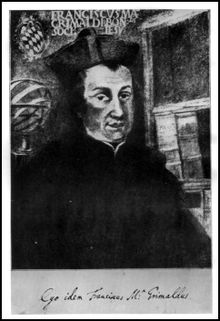Francesco Maria Grimaldi
Francesco Maria Grimaldi (born April 2, 1618 in Bologna ; † December 28, 1663 ibid) was an Italian Jesuit , physicist , mathematician and astronomer.
Grimaldi joined the Jesuit Order in 1632, received a doctorate in theology in 1647, and was ordained a priest in 1651. He taught at the Jesuit College in Bologna.
physicist
Grimaldi observed different colors when light was refracted by a prism . He also studied the behavior of light at a slit and coined the term diffraction or diffraction . He also observed and described the phenomenon of interference . In his treatise “De lumine” published in Bologna , Grimaldi was the first physicist to describe light as a wave. His fundamental work in optics formed the basis for more detailed investigations, which were carried out much later by physicists such as Isaac Newton , Christiaan Huygens , Thomas Young or Augustin Jean Fresnel and were able to confirm his assumptions and finally explain them theoretically.
astronomer
In addition, Grimaldi dealt with selenography . After observing with the telescope, he tried to draw maps of the moon as precisely as possible. In 1651 his teacher Giovanni Riccioli published one of his lunar maps in the multi-volume work Almagestum novum astronomiam veterem novamque complectens observationibus aliorum et propriis novisque theorematibus, problematibus ac tabulis promotam . One of the reasons why this lunar map is so remarkable is that the lunar structures were given names that are largely still valid today. For example, prominent points on the moon were named after famous astronomers , scientists and philosophers , the light areas were called Terrae (plural of Latin terra , "land"), the dark areas (assuming water) as Maria (plural of Latin mare , "Sea"). However, Grimaldi's map of the moon was not as precise and detailed as the Selenographia sive Lunae Descriptio published by Johannes Hevelius in 1647 .
Namesake
In honor of Francesco M. Grimaldi, two lunar structures were named after him:
- the Grimaldi crater with the coordinates 5 ° 30 'south / 68 ° 18' west and a mean diameter of 172 km; it was named by the International Astronomical Union (IAU) in 1935;
- the Grimaldi grooves (Rimae Grimaldi) with the coordinates 9 ° 00 'south / 64 ° 00' west and a mean diameter of 230 km; the name was given by the IAU in 1964 after the neighboring crater.
Publication (selection)
- Physicomathesis de lumine, coloribus, et iride, aliisque annexis , Bologna 1665
Web links
- Moon maps according to Hevelius and Riccioli ( Memento from September 4, 2005 in the Internet Archive )
| personal data | |
|---|---|
| SURNAME | Grimaldi, Francesco Maria |
| BRIEF DESCRIPTION | Italian Jesuit, physicist and mathematician |
| DATE OF BIRTH | April 2, 1618 |
| PLACE OF BIRTH | Bologna |
| DATE OF DEATH | December 28, 1663 |
| Place of death | Bologna |
